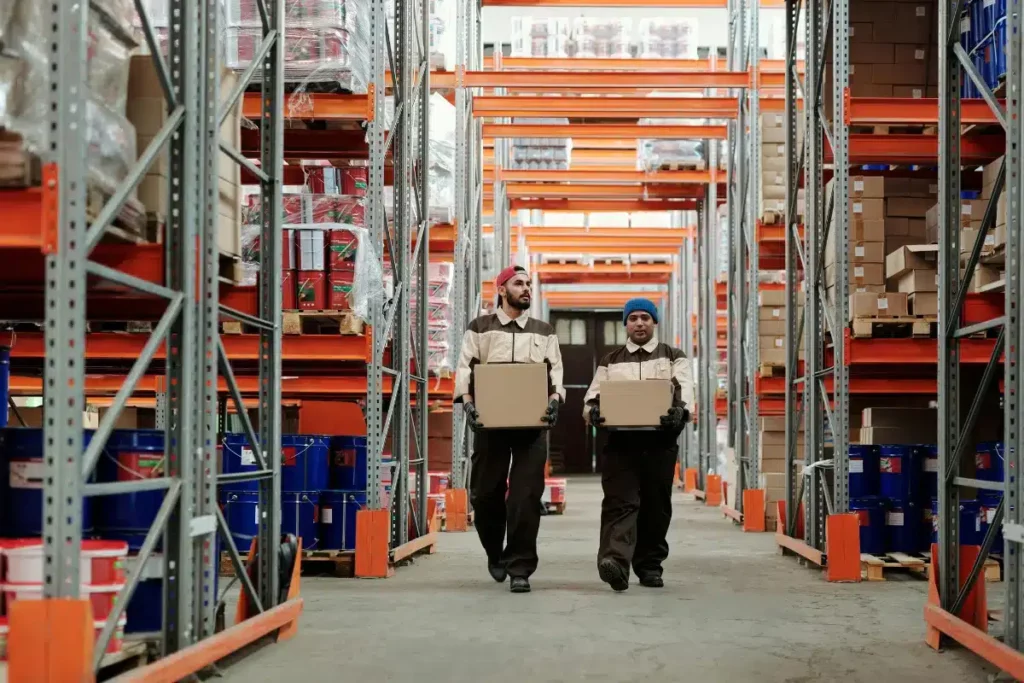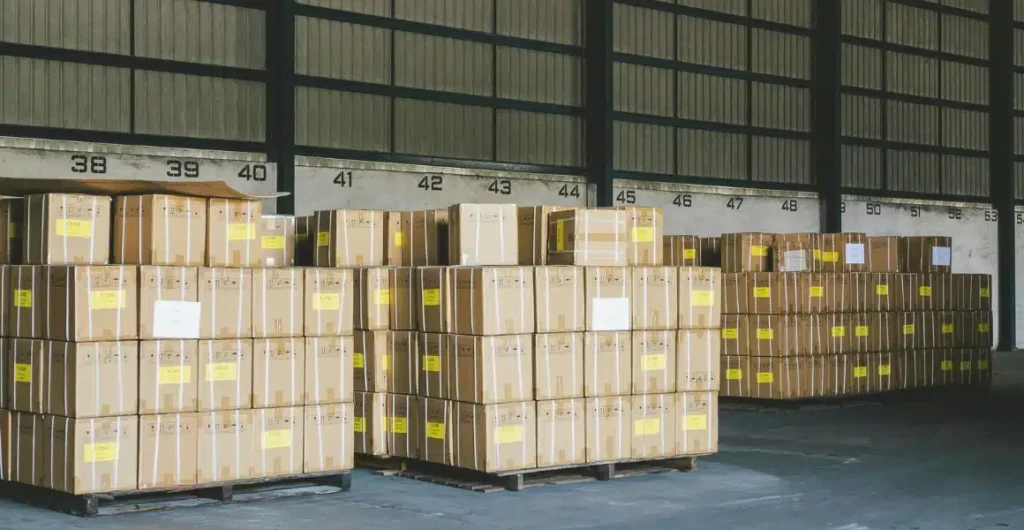
Have you ever wondered about the intricate behind-the-scenes mechanics that take a product from being a picture on your website to a real item in a customer’s hands?
Who gets the notification to send the product? How do they find it, prep it and ship it? Where is it sent from?
For many companies, the product is likely to be sent from a fulfillment center – the unsung heroes of modern commerce. But what is a fulfillment center?
Whether you’re a seasoned entrepreneur or just dipping your toes into the world of e-commerce, understanding fulfillment centers is key to unlocking efficient, customer-centric operations.
In this article we talk about exactly what fulfillment centers are, how they work, and explore some of the latest trends in the world of fulfillment that could benefit you and your business.
What is a fulfillment center?
A fulfillment center is a specialized warehouse dedicated to the receiving, storing, inventory management, picking & packing and shipping of goods. It may be owned by a larger business and only fulfill the products of its parent company; or it can handle a variety of items from a selection of different businesses such as e-commerce, B2B and D2C brands or other companies with high order volumes.

How does a fulfillment center work?
Most – if not all – fulfillment centers will perform these tasks as part of their operations:

What’s the difference between a fulfillment center and a warehouse?
The principal difference between a fulfillment center and a warehouse is the value-adding activities that are performed alongside the storage of goods. It’s not always a simple matter of products coming in and those same items going back out. While at the fulfillment center, raw goods may be assembled into kits or put into particular packaging, and a finished product is going to your end consumer.
Here is a comparison between the general points of a warehouse and a fulfillment center:
| Fulfillment Center | Warehouse | |
| Principle purpose | Fulfilling customer orders quickly and efficiently. | Storing goods long-term, whether that’s weeks, months or even years. |
| Inventory turnover | Fast. Goods held in the fulfillment center are actively available for purchase, or there until needed by a client, usually only a matter of days or weeks. | Varied, but often slow. Goods may be stored for years, but some warehouses work as cross-dock facilities, combining pallets and sending them to the distribution network or retail stores. |
| Clientele | E-commerce businesses, direct-to-consumer brands and companies with high order volumes. | Businesses needing storage space. |
| Services | Storage, picking, packing, shipping, kitting, labeling, returns processing. | Storage, inventory management, security, and sometimes light packaging or assembly. |
| Layout | Designed for efficient order fulfillment, with designated areas for picking, packing and shipping. | Large, open spaces with efficient racking systems to maximize storage capacity. |
| Technology | Highly reliant on advanced technology like warehouse management systems (WMS), order management systems (OMS), and automation tools. | Less reliant on advanced technology, primarily focused on inventory tracking and management. |
In addition, there are also distribution centers. These used to be the main hub for retail logistics, and they are still a major factor in the distribution of items to physical storefronts. Distribution centers take in items directly from manufacturers, then move those same items out to the stores in the correct quantities for sale — typically with short turnarounds.

What are the different types of order fulfillment?
Not all order fulfillment is outsourced to a third party. Some brands will handle all of their own product fulfillment. Typically, this will be small brands just starting out who aren’t yet dealing with volumes worth outsourcing, or more successful brands who can afford to have their own large-scale fulfillment divisions.
Other brands will outsource the fulfillment of some product lines but not others. Here is a general overview of the three different types of fulfillment:
In-house fulfillment
In-house fulfillment is when a business handles the entire fulfillment process independently. This includes renting or owning a warehouse, storing inventory, picking and packing orders, and liaising with carriers.
This approach offers businesses complete control over the fulfillment processes, so they can be customized to their exact needs. If a SKU needs to be stored in a particular way or packed in a specific manner, managing fulfillment in-house gives greater assurance that these processes will be undertaken exactly as specified. In-house fulfillment also tends to be cheaper to run in the long term, especially for businesses that deal in high product volumes.
However, despite these advantages, managing fulfillment entirely in-house is highly capital intensive — in both physical and technical infrastructure, as well as in human capital. Not only are there substantial upfront costs involved in setting up a fulfillment center, maintenance is very expensive, too. Scaling operations up and down according to demand is also difficult and resource-intensive, making it a poor choice for businesses with highly seasonal products.
Consideration also needs to be given to location. If a brand has customers all over the U.S., it may want to choose a warehouse location in the Midwest. However, this will also make it impossible to manage next-day fulfillment to locations on either coast. If they still want to achieve rapid fulfillment, they will have to purchase multiple locations, increasing costs even further.

Outsourced fulfillment/Fulfillment as a Service (FaaS)
Outsourcing means handing the reins of your fulfillment operations over to a specialist third party. This incurs much lower upfront costs than doing everything in-house, as there is no need to purchase or rent a warehouse to operate from, or buy/build your own fulfillment technologies, as a fulfillment provider will have their own.
The scale that outsourced fulfillment or Fulfillment as a Service providers work at enables them to price themselves at a level that is competitive for most businesses, especially startups and growing brands. FaaS can also be ramped up and down much more quickly and cost-effectively than in-house operations, due to their existing infrastructure, flexible workforce and pre-built systems and processes.
Third-party fulfillment companies may have locations all over the U.S., so brands can have much wider coverage for their rapid fulfillment, without needing to own multiple warehouses.
On the downside, when you hand over your fulfillment operations to a third party, you’re inevitably giving up some control over the process. As a result, it’s more difficult to guarantee that all work will meet your standards of quality.
Hybrid fulfillment
Hybrid fulfillment pairs elements of both in-house and outsourced fulfillment. A business may handle the fulfillment of high-demand or fast-moving items itself, but outsource the fulfillment of slow-moving or bulky items, or items requiring small runs of specific value-added touches, depending on their capabilities and resources. This allows for the scalability and cost-effectiveness of outsourced fulfillment, while maintaining the flexibility of an in-house operation.
The only potential downside is that a hybrid approach can be more unwieldy to manage than either in-house or outsourced fulfillment. By segregating their operations in this way, some business leaders find there’s more scope for inconsistency between the two operations.
Trends in fulfillment
Fulfillment is a continually expanding and developing industry, with e-commerce fulfillment in North America alone predicted to grow by 13.9% per year between now and 2030. The continuing development and deployment of technology within the industry has also led to new approaches in how fulfillment is undertaken.
Subcontracting within fulfillment centers
Some fulfillment centers are offering their warehouse space for other companies to rent. This allows these other companies to run their own fulfillment operations without the expense of renting or purchasing their own property. This may be an entire warehouse that is rented out to other providers or just a portion of one, due to the owner not needing the entire area.
There can be multiple companies working from this single space, each handling their own fulfillment, but using the center’s space, facilities and shipping systems. This can be ideal for smaller fulfillment providers that lack the finances to hire an entire warehouse, or those that want to have smaller operations in a large number of locations, perhaps with the aim of providing clients with same-day or next-day delivery.

Virtual warehousing
More sophisticated fulfillment companies are now offering to set up “virtual warehouse” software on the site of customer companies. This software allows other companies to manage and track their fulfillment operations within the existing warehouse, even if they don’t physically manage the fulfillment activities themselves.
The result is a scenario where a portion of the fulfillment center might be running on this “virtual warehouse” technology, even though the physical fulfillment happens within the original center. This benefits the customer company, which gains access to the advanced features and seamless integration of the virtual warehouse software, as well as the fulfillment software provider, which is paid for the portion of the operations it facilitates.
Increasing automation
Fulfillment centers are increasingly adopting automation technologies like robots and automated storage/retrieval systems (AS/RS). Despite the obvious upfront costs associated, fully automating a fulfillment center can greatly improve efficiency, accuracy and scalability in the long term. Robots can work 24/7 (minus maintenance), will only make mistakes if items are mislabeled or in the wrong location, and have much less variation to their operations than human fulfillment workers.
Fulfillment centers can also be designed around them. With no need for break rooms or restrooms, fulfillment providers can maximize storage capacity within a limited space. There is even a benefit in the reduction of accidents and injuries, due to the minimal human interaction in the fulfillment process. This saves the fulfillment company the expense of fighting legal cases or paying workers’ compensation.
Final thoughts
Fulfillment centers are central to modern e-commerce. From streamlining inventory management to orchestrating seamless order processing and shipping, these facilities are pivotal in ensuring customer demands are met with efficiency and precision.
In an ever-evolving landscape, the right fulfillment partner can make all the difference. At Harte Hanks, we offer outsourced fulfillment services, along with a large number of other value-adding services. Beyond the core fulfillment processes, we also offer print fulfillment, kitting, logistics and freight services and dedicated account management, granting you the ability to tailor your outsourced operations to your brand’s unique needs. With Harte Hanks, you don’t just gain operational excellence but also peace of mind, knowing that your fulfillment processes are in expert hands.


